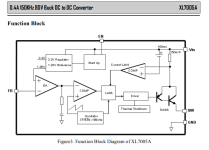Thankfully low voltage is more than adequate.
The more I see about these things the more I like. It seems like the primary issue is that they are somewhat noisy on the output. 100mv peak to peak is not uncommon and the ones advertised as "low noise" are still about 20-40mv peak to peak.
But the noise that is generated is high frequency rectified ac ripple which hopefully won't be too hard to filter out.
The more I see about these things the more I like. It seems like the primary issue is that they are somewhat noisy on the output. 100mv peak to peak is not uncommon and the ones advertised as "low noise" are still about 20-40mv peak to peak.
But the noise that is generated is high frequency rectified ac ripple which hopefully won't be too hard to filter out.
The other gotcha about charge pumps is their relatively high output impedance, in the realms of 10s of ohm. The AC ripple is easier to filter out on the newer, higher frequency devices like LM2662 : https://www.aliexpress.com/item/32901432544.html
You could roll your own charge pump that takes +58V input and produces +68V output, using off the shelf parts + some circuit design
Fortunately, in this application (boosted gate voltage for Nch MOSFET capacitance multiplier), the charge pump's required output current is small, there's no required maximum output impedance, and any fed-through clock noise will be heavily filtered since it's a capacitance multiplier after all.
_
- +58VDC --> downregulate to +15V --> NE555 oscillator creates 13V square waves --> capacitors and diodes --> +68VDC
Fortunately, in this application (boosted gate voltage for Nch MOSFET capacitance multiplier), the charge pump's required output current is small, there's no required maximum output impedance, and any fed-through clock noise will be heavily filtered since it's a capacitance multiplier after all.
_
I am working with some Lithium iron batteries and I would like to clean up their noise a bit to make them perform a bit more like Nicad or Alkaline batteries without sacrificing power density.
Just curious, can you scope and post noise across battery terminals?
Would love to see peak to peak voltage , frequency, waveform, etc. , to know what are we trying to solve.
Thanks.
Awkwardness arises because it's neither simple nor cheap to build a square wave oscillator which runs from a +58VDC power supply.
The simplest solution, assuming that 150kHz is an acceptable frequency, would be to repurpose an XL7005A buck controller IC to operate just as an oscillator.
The simplest solution, assuming that 150kHz is an acceptable frequency, would be to repurpose an XL7005A buck controller IC to operate just as an oscillator.
I'm not sure this would work, the oscillator output is not push-pull. I doubt it can pull down all the way to the bottom supply rail in 3.3 microseconds (half-period of 150 kHz) when driving the flying capacitor in a charge pump.
_
Attachments
Ha, good catch. I wonder if there's a sync buck that could handle it, I'll look around.
How about LM5164? www.ti.com/lit/ds/symlink/lm5164.pdf Could be a problem that its not constant freq, rather constant on-time.
How about LM5164? www.ti.com/lit/ds/symlink/lm5164.pdf Could be a problem that its not constant freq, rather constant on-time.
Last edited:
One could sample the Vcc ripple, invert the AC portion and drive the optocoupler with a the inverted and modulated current.On second thought, that's not going to work out too well, at least not in its simplest terms.
A couple of transistors and you're done. We're not dealing with a lot of high frequency stuff, just ripple,
- Home
- Amplifiers
- Solid State
- Looking for low drop N channel mosFET or BJT
